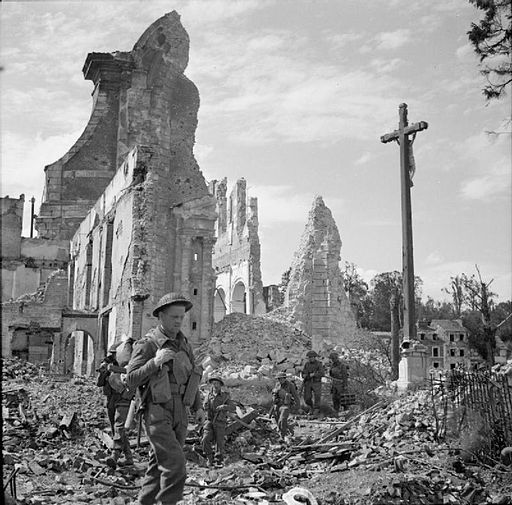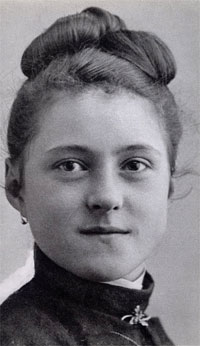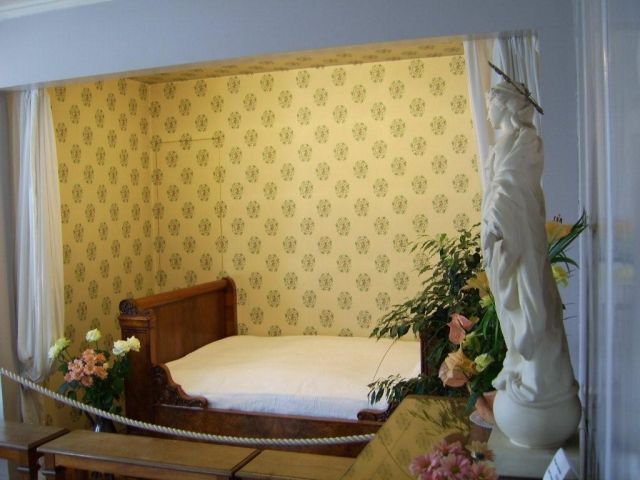Saint Therese of the Child Jesus
of the Holy Face
Entries by Maureen O'Riordan (555)
"The Miracle of Lisieux: An eyewitness account by a Carmelite of Lisieux of the bombing of Lisieux on June 6, 1944 and of the nuns taking refuge in the crypt of the Basilica until the liberation
 British troops wend their way through the ruins of Lisieux, 22 August 1944. They stand before the destroyed parish church of St. Desir, which was also the chapel of the Benedictine Abbey where St. Therese made her First Communion on May 8, 1884. The Abbey received a direct hit the day after D-Day; the great crucifix at right was unharmed.
British troops wend their way through the ruins of Lisieux, 22 August 1944. They stand before the destroyed parish church of St. Desir, which was also the chapel of the Benedictine Abbey where St. Therese made her First Communion on May 8, 1884. The Abbey received a direct hit the day after D-Day; the great crucifix at right was unharmed.
"Fire broke out in several places, and there was neither water to put it out nor firemen to fight it. We were surrounded by it and on the night of June 7 we were forced to evacuate and to find refuge in the crypt of the Basilica, where we remained until August 27."
These lines are from a letter dated September 8, 1944, written by Sister Anne of Jesus, a Carmelite nun of Lisieux, and addressed to the Carmelite community at Three Rivers, Quebec. The letter is quoted extensively in the story "Carmelites Reveal 'Miracle of Lisieux'": Petition to Mary and St. Therese Brings Protection of God," published by the Arkansas Catholic, November 3, 1944. Please click on the title to read this eyewitness account of the fate of the Carmelite nuns of Lisieux. During the terrible bombing of June 6-7, 63 nuns from various religious communities in Lisieux died. All the Carmelite nuns survived. We are most grateful to the archives of the Arkansas Catholic for the chance to share this historic account with you. Please do click to see a legible scan of the actual 1944 newspaper with this amazing story. This entry is in honor of the 70th annniverary of D-Day.
Thanks to the Southern Cross newspaper, I have been able to verify that the photograph above shows British troops standing amid the ruins of the parish church of St. Desir, which was next to the Benedictine Abbey of Notre Dame du Pre, where St. Therese made her First Communion on May 8, 1884, sixty years before.
Pope Francis visits Jerusalem in May 2014: was St. Therese there before him?
 Photo courtesy of the Shrine at Lisieux
Photo courtesy of the Shrine at Lisieux
In July 2013, when Pope Francis went up the stairs of a plane en route to World Youth Day in Rio de Janeiro, he was carrying a small black traveling bag. When the journalists asked what it contained, he mentioned a book about St. Therese, his favorite saint, whose spirituality inspires him so deeply. As Pope Francis visits Jerusalem, do you know that St. Therese was, in a sense, there before him?
St. Therese preceded the Pope not only in the visit of her relics to the Holy Land in 2011 but also because Mother Xavier of the Heart of Jesus, a nun professed at the Lisieux Carmel, helped in founding the Carmelite monastery in Jerusalem, known as the Pater Noster Carmel and still located on the Mount of Olives, the site of the Garden of Gethesemane where Jesus prayed the night before his saving death. The presence of a Carmel in Jerusalem is significant for many reasons: one is that Therese's Carmelite Order originated in the Holy Land. See our short story Origins of the Carmelite Order.
A bond between the Carmelites of Lisieux and of Jerusalem by way of--Saigon!
The link between the Carmels of Lisieux and of Jerusalem passed through the founding of the Carmel in Saigon. The Lisieux Carmel had a fervent missionary consciousness, and in 1861, only 23 years after its foundation, the community sent four French nuns to found a Carmel in Saigon. France was then engaged in conquering Indochina, which became a French colony in 1887, and Saigon had just fallen to the French in 1859. To found a religious house in the territory that was then called “Cochin-China," French citizens, who could communicate with the government, were vital. From this Saigon Carmel later sprang the Carmel at Hanoi and then all the Carmels in the Far East. Indeed, Sister Anne of the Sacred Heart, a professed nun of Saigon, came to the Lisieux Carmel and lived with St. Therese for seven years, returning to Saigon in 1895. St. Therese writes of how much she herself would have liked to go to this mission Carmel of Saigon but her health prevented it.
Mother Xavier of the Heart of Jesus, Carmelite of Lisieux, and the Carmel of Jerusalem
[The information in this section comes chiefly from the circular of Mother Xavier, which appears in French on the Web site of the Archives of the Carmel of Lisieux; I'm grateful for permission to draw on it].
One of the nuns who came out to Saigon from Lisieux, Mother Xavier of the Heart of Jesus, played a vital role in founding the Carmel in Jerusalem. Mother Xavier had been born in Lisieux to a devout Christian family; her baptismal name was Marie. At sixteen she felt a call to the religious life, and finally applied to the Carmel of Lisieux. When told that she could not enter Carmel until her twenty-first birthday, she decided to leave home for Carmel on that very birthday.
Sister Xavier was so fervent a novice that she inspired her young companions and was “the consolation of the community.” After her profession, the bishop of Cochin (now Vietnam) asked the Carmel of Lisieux to found a Carmel in Hanoi. Sister Xavier volunteered, and the four foundresses arrived in Saigon in 1861 under the guidance of their prioress, Mother Marie-Philomene. Two of them, whose health could not adapt to Vietnam, returned to Lisieux, leaving Sister Xavier with the Prioress in Saigon. Though Mother Xavier loved Vietnam, God had long ago inspired her with the desire to help establish a Carmel in the holy city of Jerusalem. After nine years at Saigon, she returned to France to help bring together nuns for a foundation in Jerusalem. The Carmel of Carpentras supplied the founding nuns for the Jerusalem Carmel, and Mother Xavier accompanied them to the Holy Land, where the “Paternoster Carmel” (the Carmel of the ‘Our Father’”) was inaugurated in 1874 on the Mount of Olives. The Carmelite nuns live there today. On the nuns' Web site, see a photo of the monastery and read about the Italian princess who had prepared a building for the monastery; also read Mother Xavier’s ecstatic description of the view of Jerusalem from the site.
At about 15, St. Therese turned down a chance to visit the Holy Land

The future St. Therese might well have visited that Carmel had she not refused an offer from her father at the end of 1887 or the beginning of 1888. On the Feast of All Saints in 1896 Sister Therese of the Child Jesus wrote to Father Adolphe Roulland, a young French missionary priest in China for whom she prayed especially, referring to the pilgrimage to Rome she made before her entrance:
Before becoming the prisoner of Jesus, I had to travel very far to take hold of the prison that I preferred to all the palaces of this earth. I had no desire to make a trip for my personal pleasure, and when my incomparable father offered to take me to Jerusalem if I wished to postpone my entrance for two or three months, I did not hesitate (in spite of the natural attraction which was drawing me to visit the places sanctified by the Saviour's life) to choose repose in the shadow of Him for whom I was longing." I understood that really one day spent in the Lord's house was worth more than a thousand anywhere else.
[Letters of St. Therese of Lisieux, Vol. II. Washington, D.C.: ICS Publications, 1988, p. 1017].
How much this sounds like Mother Xavier, who did not waste a single hour of her twenty-first birthday before hastening to Carmel! And it was of the first three months of 1888, which she had to spend still waiting to enter, that Therese later wrote “God showed me the value of time.” On April 9, 1888, she joined Mother Xavier’s former companions at the Lisieux Carmel.
The bond between the Carmels of Jerusalem and Lisieux when St. Therese was alive
The other Carmels in the Holy Land, in Bethlehem, Haifa, and Nazareth, were all founded by French Carmelites from the 1870s through the 1890s. With this strong connection to France the Lisieux Carmelites, including Therese, must have kept these burgeoning communities in their prayers and have received regular communications from them. After the death of a French Carmelite, her “obituary circular” (a short account of her life and vocations) was sent to the other French Carmels. [In fact, “Story of a Soul,” Therese’s famous memoir, came into being as a substitute for the usual circular]. At Lisieux, these circulars were read aloud during meals. During Therese’s years at Carmel, four nuns from France died in the Carmel of Jerusalem, and she heard their stories during meals. The first was Mother Xavier of the Heart of Jesus, who died on June 28, 1889, during Therese’s novitiate. The Carmels were notified of her death in July, but her prioress, Mother Aloysia, could not write the story of Mother Xavier’s international mission alone. For Mother Xavier’s life in France, Mother Aloysia drew on accounts from Lisieux:
“Until now [in the circular], we have virtually transcribed the details given to us by the good and worthy mothers who guided the first steps of our dear Sister Xavier in the religious life and who tasted with her the joys of family life in her dear Carmel of Lisieux.”
Mother Aloysia wrote this circular on December 15, 1889, and, after it reached Lisieux, Therese heard it in the refectory along with the other nuns, several of whom had lived with Mother Xavier at Lisieux.
Therese must have shared the news of the Jerusalem Carmel with her sister Celine, who was then living as a laywoman with their father. Within six weeks of his death in 1894 Celine entered Carmel, but not without opposition from her cousins. On August 19, 1894, Celine wrote to Therese about the bitter opposition of Jeanne Guerin, the daughter of Therese’s maternal uncle Isidore, and her husband, Francis La Neele:
And they are pitiless when it comes to souls consecrated to God; it seems that religious deserve everything when it comes to contempt and trouble, and Jeanne would have preferred to see me go to Jerusalem rather than to Lisieux.
[Letters of St. Therese of Lisieux, Vol. II. Washington, D.C.: ICS Publications, 1988, p. 880. A footnote to this letter reminds us that Mother Marie de Gonzague was carrying on a correspondence with Mother Aloysia at Jerusalem and that Therese herself had occasion to write to the Carmel of Jerusalem. We don’t know when Therese wrote, and, sadly, her letter is lost].
A souvenir of the correspondence between the two Carmels is displayed on the Web site of the Archives of the Carmel of Lisieux. On April 30, 1896, Sister Marie of the Trinity made her profession. As was the custom, she gave her young novice mistress, Sister Therese of the Child Jesus, as a souvenir, a holy card from the Jerusalem Carmel: an image of the Child Jesus on the Mount of Olives with the words “Flowers on the Mount of Olives, blessed on the Holy Sepulchre.” The Paternoster Carmel remains on that mountain today.
The Paternoster Carmel: St. Therese and the Fatherhood of God
The Jerusalem Carmel is called “Paternoster” (the Latin for “Our Father”) because it was built near the cave traditionally believed to have been the place where Jesus taught his disciples the “Our Father.” It’s fitting that this Carmel is bonded to the Lisieux Carmel, in which was forged the sanctity of St.Therese, who illumined for us the mystery of the divine Paternity.
St. Therese had a passionate love of God the Father. When her own father was interned in a mental hospital, she wrote to her sister Celine: “Now we are orphans, but we can say with love, ‘Our Father, who art in heaven.’ Yes, there still remains to us the only All of our souls.” Celine described an incident that took place later, after she had joined Therese in Carmel:
On entering Therese’s cell one day, I was struck by her heavenly expression of recollection. Although she was sewing industriously, she seemed to be lost in profound contemplation. When I inquired “What are you thinking about?” she replied with tears in her eyes, “I am meditating on the Our Father. It is so sweet to be able to call God our Father!” (A Memoir of My Sister St. Therese. NewYork: P. J. Kenedy & Sons, 1959, p. 109).
In her final illness, Therese is reported once to have spoken of God as “Papa le bon Dieu.” Someone thought she must have spoken by mistake, but she answered with feeling, “Why, yes, he is my Papa, and I love to call Him that.”
When Pope John Paul II visited Lisieux on June 2, 1980, he said:
Of Thérèse of Lisieux, it can be said with conviction that the Spirit of God permitted her heart to reveal directly to the people of our time the fundamental mystery, the reality of the Gospel: the fact of having really received the filial spirit when we cry, “Abba! Father!” . . . . What truth of the Gospel message is, in fact, more fundamental and more universal than this one: God is our Father and we are his children?
In the sanctuary, visited by many pilgrims, the “Our Father” is written on the walls in many different languages. On the Web site of the Carmel of the Holy Land, please see a photo of the community (representing nine different countries) and a short description, ending with the words so appropriate to St. Therese: “By living in community the message of Pater Noster with joy and faithfulness, our experience of God’s paternity will help us live in fraternity with Christ.
A play named for St. Therese comes to Jerusalem
In 2012, Michel Pascal’s play based on St. Therese was presented at the Jerusalem Carmel. Eva Hernandez, the actress who played Therese, said that in the Holy Land, “I sense that I am nothing but a messenger, a tool at the service of St. Therese…I feel serene while playing here…I believe that while here in the Holy Land, I have become more and more aware of the goodness of this work. It is like a prayer.”
Playwright Michel Pascal says that “Therese is especially relevant in our age. She touches by her simplicity…Therese can bring together all religious. Not only Christians but also Muslims, Jews, atheists, and Buddhist monks have come to see the play. “Therese makes an impression,” said Pascal. “She upsets all by her littleness.”
The relics of Saint Therese in the Holy Land – March 14, 2011 – May 31, 2011
In a sense, Pope Francis was preceded to the Holy Land by his favorite saint. Therese had longed to follow in Mother Xavier’s footsteps to Saigon, and, as a teenager, had felt a “natural attraction” to visiting the Holy Land. Although she could not go there during her lifetime, more than a century after her death she visited it by means of her relics. On March 14, 2011, about sixty nuns, priests, and Catholics welcomed them on arrival (see Washington Post, March 14, 2011). Before the relics left Israel on May 31, 2011, thousands of the faithful had venerated them.
Above, a video of the crowds surrounding the reliquary of St. Therese as it is carried through the narrow streets. On May 26, 2011, just three years ago today, the relics of the young nun who wrote to the Paternoster Carmel were received at that Carmel. The visit was a wellspring of grace. (Read the full story in Asia News at Catholic Online). Mgr Shomali, Bishop of Jerusalem, said: "The prayers in honour of the Saint and the requests for grace made during the pilgrimage have laid a bridge of peace and hope between the peoples of the Holy Land, especially the faithful in the Gaza Strip."
In his visit to the Holy Land this weekend, Pope Francis issued an invitation to peace while he was at Manger Square in Bethlehem:
In this, the birthplace of the Prince of Peace, I wish to invite you, President Mahmoud Abbas, together with Israeli President Shmon Peres, to join me in heartfelt prayer to God for the gift of peace. I offer my home in the Vatican as a place for this encounter of prayer. "Building peace is difficult, but living without peace is a constant torment. The men and women of these lands, and of the entire world, all of them, ask us to bring before God their fervent hopes for peace.
May God hear the prayers of St. Therese, of Pope Francis, of the two presidents, and of all people of good will for "the gift of peace."
Origins of the Carmelite Order: the Holy Land
by Mary Davidson and Maureen O'Riordan for "Saint Therese of Lisieux: A Gateway"
Photo credit: Elif Milim Yagur, GFDL
The Carmelite Order originated in the Holy Land, specifically on Mount Carmel, a small range of mountains in Israel. Carmel was the site of the spring of St. Elijah, where the great prophet was fed by ravens, raised the widow’s son from the dead, and showed his great zeal for the Lord (I Kings 17-19). When Elijah sought the Lord, he found that the Lord was not in the hurricane, nor the earthquake, nor the fire, but in the murmuring breeze--in other words, in the silence. It is from the lips of St. Elijah that the Carmelites take their motto: “With zeal I have been zealous for the Lord, God of Hosts” (I Kings 19:14).
In the 13th century, a small group of hermits came to Mount Carmel to establish a spiritual community in the prayerful tradition of St. Elijah. They became known as the Brothers of the Blessed Virgin Mary of Mount Carmel. For over 800 years, this holy mountain (120 km from Jerusalem) has been the spiritual home of all Carmelites. This history is part of the Carmelite formation, and certainly Therese and her Carmelite sisters at Lisieux were familiar with it. Therese refers to this mountain when she writes “I left on my dear King’s arm to climb Mount Carmel.”
Today the Carmelite Order has two branches. The Carmelites of the Ancient Observance include friars, sisters, and lay members descended from those first Brothers of the Blessed Virgin Mary of Mount Carmel. Most of the friars and sisters write “O. Carm.” (for “Order of Carmelites”) after their names, and the lay members write “T. O. Carm.” (for Third Order Carmelite).
The other branch of the Carmelite family, and the one to which St. Therese belonged, is called the Discalced Carmelites. “Discalced” means “barefoot,” and it refers to the practice of wearing sandals, not shoes. St. Teresa of Avila founded the first monastery of Discalced Carmelite nuns in Avila in 1562, and this Order is also sometimes known as the "Teresian Carmel." This branch also includes friars, nuns, and lay members. The friars and nuns use the abbreviation “O.C.D.” The lay persons are members of the Secular Order of Discalced Carmelites and use the abbreviation “OCDS.” Some of the Spanish Carmelites formed by Teresa came to France and established Carmel there, and that led to the founding of the Carmel at Lisieux in northern France 1838. St. Therese entered that monastery fifty years later. The monasteries of Discalced Carmelite nuns are commonly called “Carmels,” but this name is shorthand for “monastery of the Blessed Virgin Mary of Mount Carmel.”
The 89th anniversary of the canonization of St. Therese of Lisieux on May 17, 1925

Although we have since become accustomed to the canonization of persons in living memory, in the time of St. Therese's canonization it was unheard of. She was canonized only twenty-eight years after her death, the fastest canonization of modern times. Had she lived to see it, she would have been only 54 years old.
Celebrate her canonization by:
- Reading the Bull of the Canonization of St. Therese by Pope Pius XII, a letter which begins "Vehemently do we exult today, and we are filled with the greatest joy . . ."
- Reading the Homily of Pope Pius XI at the Mass of Canonization of St. Therese.
Excerpt: Therefore do We desire earnestly that all the Faithful of Christ should render themselves worthy of partaking in the abundant profusion of graces resulting from the intercession of "little Thérèse." But We desire much more earnestly that all the faithful should study her in order to copy her, becoming children themselves, since otherwise they cannot, according to the oracle of the Master, arrive at the Kingdom of Heaven.
If the way of spiritual childhood became general, who does not see how easily would be realized the reformation of human society which We set ourselves to accomplish at the commencement of our Pontificate, and more especially in the promulgation of this Jubilee.1 We, therefore, adopt as our own the prayer of the new Saint Thérèse with which she ends her invaluable autobiography: "O Jesus, we beseech Thee to cast Thy glance upon the vast number of little souls, and to choose in this world a legion of little victims worthy of Thy love." Amen.
- Read online a short and vivid description of the canonization of St. Therese from John Beevers' book Storm of Glory. Thanks to Hathitrust for digitizing it. Beevers mentions that Pope Pius XII, who canonized St. Therese, told Cardinal Dougherty, in his audience in the afternon, that it was the happiest day of the Pope's llife.
"Our Lady was very beautiful, and I saw her smile at me" - St. Therese's cure by the Blessed Virgin on May 13, 1883

May 13 is the anniversary of St. Therese's cure by the Blessed Virgin at age 10 (131 years ago, in 1883). Read about the cure and the history of the statue here.